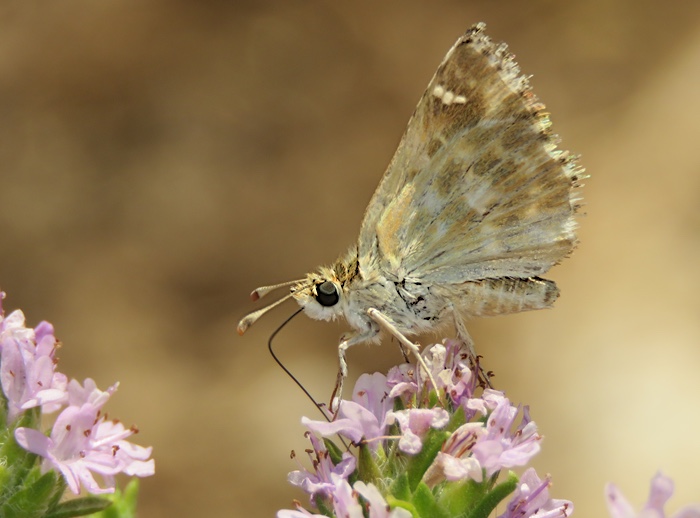
Male, Málaga, July 2021

Male, Málaga, July 2021

Female, Málaga, July 2021

Female, Málaga, July 2021

Málaga, July 2021

Málaga, July 2021

Málaga, July 2021

Málaga, July 2021

Málaga, July 2021

Distribution
This Carcharodus
skipper has a strongly south-westerly distribution, flying in most of
Iberia, the South of France and in scattered populations in Italy. Many
books say it flies in Switzerland but this is an error. It did fly in
Valais as an accidental introduction in the early 20th century but is
no longer on the Swiss list. It flies in two or three broods depending
on latitude, overlapping in many places with marbled skippers, tufted
marbled skippers, mallow skippers and false mallow skippers. I
photographed the individuals shown on this page in July 2021 at the
tail end of the second brood, when most individuals were very tatty and
the species was not numerous. False mallow skippers, Carcharodus tripolinus,
flew at the same sites.
The upperside forewing often has rather broad, hyaline or nacreous markings embossed on the dull brown ground. This is quite different from the two mallow skippers, alceae and tripolinus, which both have narrower, 'scratched' markings. Some individuals, though, like the first female shown above, had narrower markings. I am convinced nevertheless that she is baeticus. The upperside hindwing is crossed by a light band of spots, the discal spot being particularly prominent. The veins are light, giving the wings a reticulate feel. This is more obvious on the underside hindwing, which is pale - especially in the male - with whitish veins crossing more or less continuous pale bands. Care should be taken, though, as both alceae and tripolinus can give the same reticulate appearance to the naked eye. The difference is one of degree rather than kind. In my (limited) experience, the upperside is a better point of distinction from these two species.
The foodplants are various species in the mint family, with black and white horehounds being mentioned in the books. Tolman says the southern marbled skipper hibernates as a small larva.
The upperside forewing often has rather broad, hyaline or nacreous markings embossed on the dull brown ground. This is quite different from the two mallow skippers, alceae and tripolinus, which both have narrower, 'scratched' markings. Some individuals, though, like the first female shown above, had narrower markings. I am convinced nevertheless that she is baeticus. The upperside hindwing is crossed by a light band of spots, the discal spot being particularly prominent. The veins are light, giving the wings a reticulate feel. This is more obvious on the underside hindwing, which is pale - especially in the male - with whitish veins crossing more or less continuous pale bands. Care should be taken, though, as both alceae and tripolinus can give the same reticulate appearance to the naked eye. The difference is one of degree rather than kind. In my (limited) experience, the upperside is a better point of distinction from these two species.
The foodplants are various species in the mint family, with black and white horehounds being mentioned in the books. Tolman says the southern marbled skipper hibernates as a small larva.